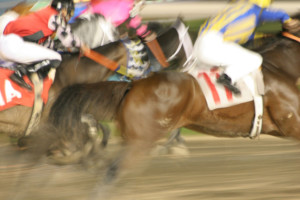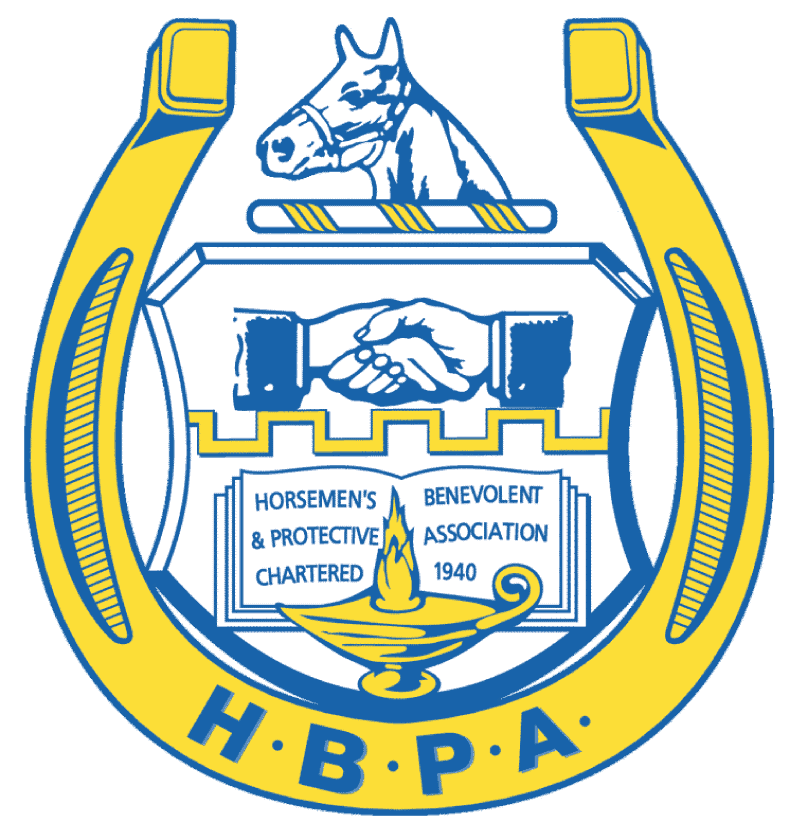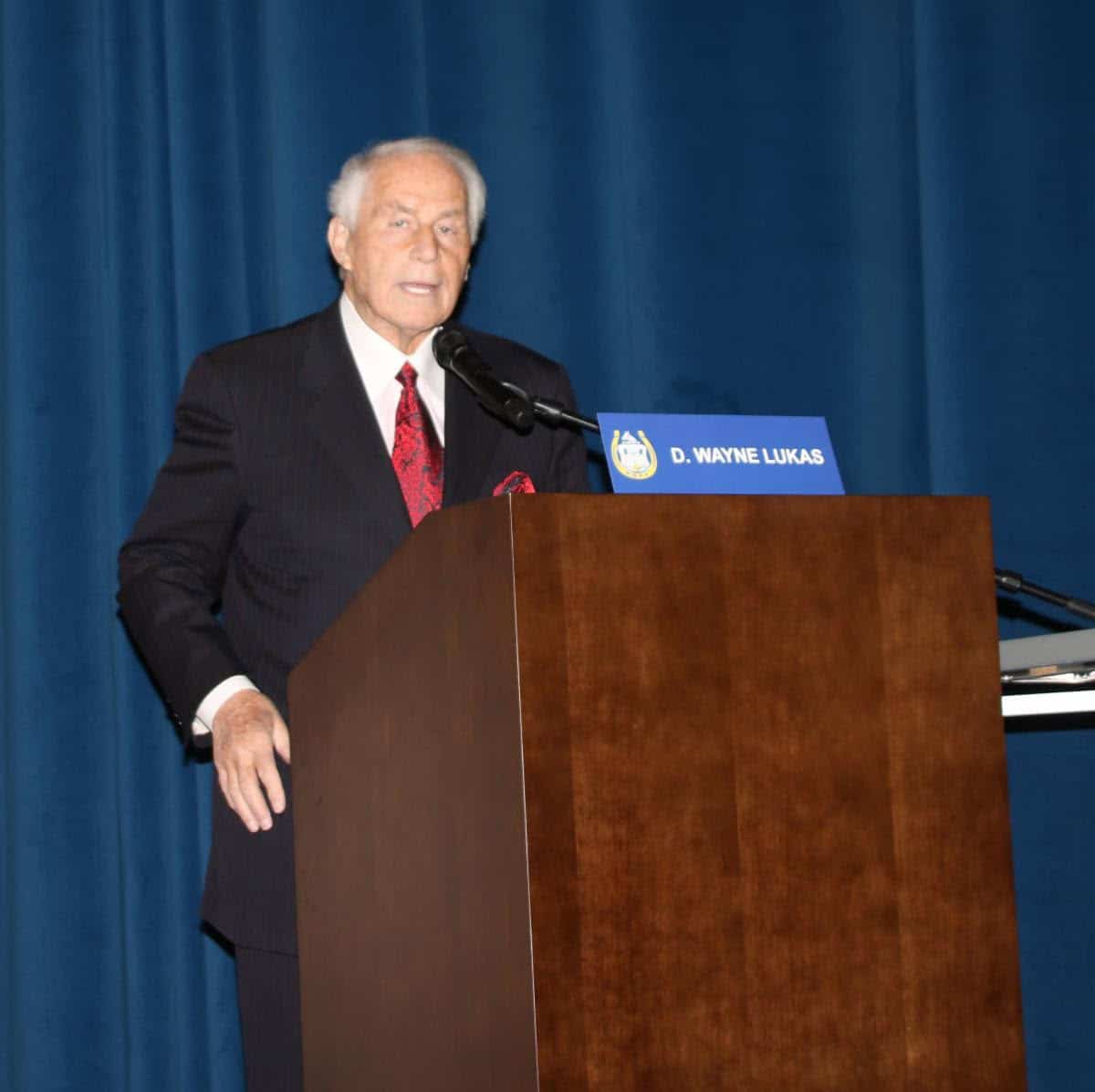Understanding EHV-1 and How to Prevent It
 UNDERSTANDING EHV-1 AND HOW TO PREVENT IT
UNDERSTANDING EHV-1 AND HOW TO PREVENT IT
By Clara Fenger, DVM, PhD, DACVIM
The North American Association of Racetrack Veterinarians (NAARV) welcomed an esteemed program of speakers to Southern California on the eve of the Breeders’ Cup for its inaugural symposium. Held November 1-2 in Carlsbad near the Del Mar Thoroughbred Club, the symposium, presented by Merck, provided our members with cutting-edge continuing education directed at the racetrack practitioner.
Sponsors, attendance and interaction from our members were exceptional. Topics ranged from an update on equine herpesvirus-1 (EHV-1) to exercise-induced pulmonary hemorrhage in Florida-based 2-year-olds racing with and without furosemide to the identification and management of diseases of the fetlock joint. Many of our members went on to join our educational partner, VetPD, for additional education on orthopedic rehabilitation at the Trifecta Equine Athletic Center in Bonsall.
Of particular interest to horsemen reading this magazine is the update on EHV-1 provided by Dr. Bryant Craig of Merck Animal Health. Recent outbreaks of EHV-1 in Arizona, Louisiana and Kentucky remind us how tenuous the health of our equine athletes can be. The outbreak at Fair Grounds that hit in late December 2016 left Gun Runner, who was being pointed to the $12 million Pegasus World Cup at Gulfstream Park on January 28, healthy and uninfected but under quarantine in his stall in Louisiana.
Perhaps many have forgotten about that situation by now, especially given how Arrogate defeated a stellar field that included California Chrome. But imagine how that race could have been even better with the inclusion of Gun Runner and how frustrating that situation must have been for that horse’s connections. It’s only a short reach to imagine the rising stars of our sport trapped in their barns as the spring stakes schedule begins, with the most promising 3-year-olds unable to set their sights on the first Saturday in May. In his timely discussion, Craig reviewed our current state of knowledge, including key research released in the past year.
DISEASES ASSOCIATED WITH EHV-1
Infection by EHV-1 causes three different syndromes, of which any one, a combination or all may affect the same horse. The first syndrome is likely the reason that the disease is so ubiquitous in the equine population. It most commonly causes a mild respiratory infection that is transient but allows the virus to replicate and be shed in the nasal passages, thereby spreading rapidly to other horses. It is typically associated with a biphasic fever (an initial elevation in body temperature followed by a later one).
The second syndrome is reproductive, whereby the virus infects the fetus and placenta, causing abortions and the production of maladjusted foals. The final syndrome, herpes myelitis, affects the central nervous system. The virus reproduces in the cells that line the blood vessels. When this infection reaches the central nervous system, the result is a lack of blood supply to the spinal cord and/or portions of the brain and brainstem, and paralysis results.
WHERE DOES EHV-1 INFECTION COME FROM?
As many as 80 percent of horses worldwide are latently infected with EHV-1. The only location completely free of EHV-1 is the tiny island nation of Iceland. Much like herpesviruses in humans, young animals are initially infected as early as a week of age, often as a nondescript or sub-clinical transient respiratory infection from which they seem to quickly recover. The virus infects nerve endings and travels to the trigeminal ganglion, the site where nerve cell bodies for the nerves that provide sensation to the face reside. There, it lies dormant, kept in check only by the body’s immune system. Under periods of stress, the virus can recrudesce, much like a cold sore in a person, and begin the respiratory signs anew. As if to complicate matters as much as possible, horses showing clinical signs of EHV-1 may have reactivated their own resident EHV-1 or contracted it from a horse that is actively shedding the virus particles.
The pathogenesis of the neurological form of EHV-1—how the virus goes from latent or dormant to replicating in the horse’s blood vessels to the central nervous system to cause the paralysis that is the disease’s hallmark—is largely a mystery. We know only that the neurological form tends to be associated with higher levels of virus particles in the blood and higher shedding of the viruses from the nasal passages.
NEUROPATHOGENIC VS. NON-NEUROPATHOGENIC (WILD TYPE)
Using neuropathogenic and non-neuropathogenic to describe different strains of EHV-1 has led to a great deal of confusion in the equine community. The assumption from the terms would be that the neuropathogenic form of the virus is the only one capable of causing the dreaded neurological form of the disease, when, in fact, neurological outbreaks have been caused by either form.
The virus strains differ by a single nucleotide in their DNA that causes several different effects, and identifying the strain can provide valuable information to researchers when tracing the origin of an outbreak. For the horsemen and veterinarians on the ground, however, the details of the virus strain are considerably less important than controlling the spread of infection, since either strain is capable of causing an outbreak of disease.
VACCINATION
Most racing associations require horses to be vaccinated for EHV-1 before entering their property, a laudable intent to safeguard both the horses and the economic venture that goes on within their borders. As in humans, the higher the proportion of the population that is appropriately vaccinated for a disease, the lower and slower its spread among the population, even if the individual vaccines employed do not have 100 percent effectiveness. Vaccination recommendations vary from 90 to 180 days, with most associations moving to 180 days in the wake of new studies on the disease.
Two studies of EHV-1 outbreaks, one in Ogden, Utah, and the other in Findlay, Ohio, showed that, in those outbreaks, vaccinating too frequently, particularly recent vaccinations, was associated with herpes myelitis. Since EHV-1 infects most horses in the world, studying how the uninfected animal reacts to vaccination is difficult—unless a group of horses is imported into an EHV-1 region from the only area free of the disease, Iceland. A group at Cornell University did just that. They found that too-frequent vaccination in a group of EHV-1 naïve horses can have a negative effect on the immune system.
This finding has led most racing associations to require EHV-1 vaccination within 180 days to optimize protection of the total population as well as to prevent the immunosuppression that may result from too-frequent vaccination.
WHICH VACCINE TO USE?
No vaccine is labeled to prevent herpes myelitis. However, high levels of viremia (virus in the blood) and nasal shedding are both associated with the neurological form of the disease, and some vaccines are better at minimizing these features than others. The so-called high-antigen-load vaccines and the modified live vaccines are highly effective at minimizing these features and should be considered in high-risk populations, such as racehorses.
Further, trainers on grounds under regulatory authority must rely on their veterinarians to vaccinate their horses, but trainers, owners and farm managers at non-regulated facilities can administer their own vaccines. They should resist the temptation to do so, even though the vaccination is available over the counter. In order to provide a vaccination certificate, a veterinarian must administer the vaccine. Therefore, horsemen risk placing their horse in harm’s way by vaccinating on their own, necessitating that the veterinarian repeat the vaccination at an interval that is too soon to ship the horse to a racetrack.
PREVENTION OF HERPES MYELITIS
A good history of twice-a-year vaccination with an appropriate vaccine to minimize viremia and nasal shedding will minimize the overall exposure in a group of horses, such as those congregating in a racing enclosure. Avoid commingling horses and using tack on multiple horses, especially when they are exhibiting respiratory signs. These are good biosecurity measures at all times. Thoroughly disinfecting stalls, buckets and other common equipment with a phenolic disinfectant is the best choice.
Herpesvirus can remain infective in the environment for days and in water even up to weeks. Monitoring horses’ temperatures daily on a routine basis—and twice daily in the face of an outbreak—with good recordkeeping is also important. Not all horses back out of the feed tub with a fever, and only careful temperature surveillance can identify those horses with disease early, thus protecting the balance of the barn.
In the face of an outbreak, a number of resources provide recommendations for disease containment, including the American Veterinary Medical Association and the American Association of Equine Practitioners. Moving actively infected horses off site or into quarantine is the first priority. Those horses that were in direct contact with the infected horse should be quarantined and nasal swabs and whole blood samples tested by PCR (polymerase chain reaction) for evidence of infection. Those horses not showing signs but remaining under quarantine should be allowed to train on the track with separate hours from the regular horse population and with restrictions on going with ponies or to the starting gate.
Horses at risk but not exposed should be vaccinated if they have not been recently. Other therapies show promise, although the evidence in horses is minimal. In a recent outbreak in show horses in Colorado, zinc supplementation was associated with a lower risk of herpes myelitis than in those not receiving supplements. In cats, L-lysine supplementation has been shown to limit herpetic disease, because L-lysine interferes with virus replication. A number of supplements that are combining these two feed ingredients can be readily obtained. It is not recommended to feed these supplements on a routine basis, because high levels of zinc interfere with copper absorption and L-lysine interferes with L-arginine use by the horse. During periods of high stress, however, and certainly during an outbreak, this supplementation is a reasonable approach.
TREATMENT OF HERPES MYELITIS
Once the damage to the spinal cord is done, intervention is difficult. While a full recovery is possible, many of these horses progress to death. The antiviral product acyclovir is minimally bioavailable (the extent to which a medication can be used by the body), and valcyclovir, while more likely to be absorbed into the horse, shows limited value unless started in the early stages of the disease. Gancyclovir, a newer antiviral drug, has greater efficacy against EHV-1 but is prohibitively expensive for most uses in horses.
A reasonably inexpensive treatment that has shown promise is the use of injectable heparin. Administration of heparin twice daily may prevent the virus from entering the cells lining the blood vessels and can also prevent the blood vessel damage that ultimately results in the clinical signs.
CONCLUSION
Careful vigilance by checking temperatures and monitoring for respiratory signs is the best protection against EHV-1 outbreaks, because early diagnosis, treatment and isolation provide the most benefit for the group. Appropriate vaccination by your veterinarian twice a year with a vaccine likely to minimize viremia and shedding, preferably well in advance of shipping to a racing or training venue, provides overall protection to the entire group of horses by minimizing exposure. Supplementing with L-lysine and zinc during periods of stress and during an outbreak may be of benefit. Gancyclovir early in the disease course is the best treatment, but heparin, a relatively inexpensive treatment, also has shown promise.
Questions about EHV-1 infection? Consult your NAARV racetrack practitioner, who is now armed with the latest information.
OTHER TOPICS
Other topics covered at the NAARV Symposium included conditions of the fetlock joint, methods of preventing catastrophic injury, thermography and endoscopy, among others. These and other topics will be covered in future editions of The Horsemen’s Journal.
(reprinted from the Winter 2017 issue of The Horsemen’s Journal)





